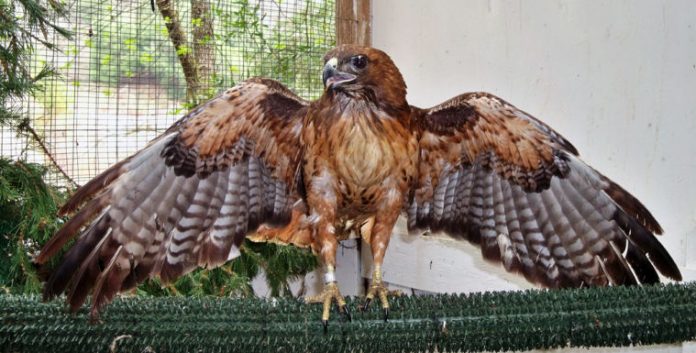The splendid red-tailed hawk was flying over the fields of Coyote Valley … with a band on. Early in February, the hawk was discovered along the side of Santa Teresa Boulevard unable to fly but with no apparent external injuries.
At the Wildlife Education and Rehabilitation Center, the hawk received a thorough examination and though no fractures or wounds were found, most of its tail feathers were broken or missing. Because of the bird’s condition and the location it was rescued, it was concluded that the hawk most likely had been sideswiped by a passing vehicle.
In addition, the hawk was severely infested with lice. Treatments with anti-lice spray have helped clear up the problem so new feathers should grow out healthy and well-formed.
But the most intriguing aspect of the hawk’s examination was the narrow metal band on its right leg, engraved with a nine-digit number and a phone number to call – which we did. According to the U.S. Geological Survey’s Bird Banding Laboratory, the hawk was banded by the Golden Gate Raptor Observatory on Oct. 17, 2009 at the Marin Headlands near Sausalito. According to the GGRO, the 1,200-gram female juvenile, which had hatched earlier that year, was captured, banded, measured and was then released 20 minutes later. She traveled at least 80 miles before she was incapacitated 4 1/2 years later.
Bird banding is the practice of placing a lightweight metal or plastic band around a bird’s leg in order to identify individual birds. Banding has been practiced for centuries, first used on falconry birds or other captive birds so they could be identified and returned if they were stolen or got lost. The first record of a metal band attached to a bird’s leg was in the late 16th century on one of King Henry IV’s peregrine falcons, which escaped but was found a day later more than 1,000 miles away. The first record of banding in North America was in 1803 by John James Audubon. Audubon tied silver cords to the legs of nestling phoebes and was able to identify two juveniles when they returned the next year. In the early 1900s, scientific bird banding with numbered metal bands was developed and included the collection and storage of banding data.
Sometimes birds are banded after they have been brought into a wildlife rehabilitation facility because of illness or injury. Some young birds in the wild may be temporarily removed from a nest in order to be banded, such as the peregrine falcon offspring of San Jose City Hall’s famed Clara, which have been weighed, sex-determined and banded each spring since 2007.
Banding provides valuable information to researchers on the condition, age and sex of the birds captured and is an important tool for studying migration patterns. Banding may also provide data on avian population, life span and causes of death. Such information increases our knowledge and understanding of birds and their habits and assists in their management and conservation.
This red-tailed hawk will recuperate at WERC until late summer or early fall. The band will remain on her leg when she’s released near the area she was found, free and wild once more.
The red-tailed hawk is just one of the many animals needing food, medications and enclosure maintenance at WERC. Help us help them by participating in the first BOWWL-a-thon from 1 to 3 p.m. Sunday, March 30 at Morgan Hill Bowl. Details: www.werc-ca.org.










